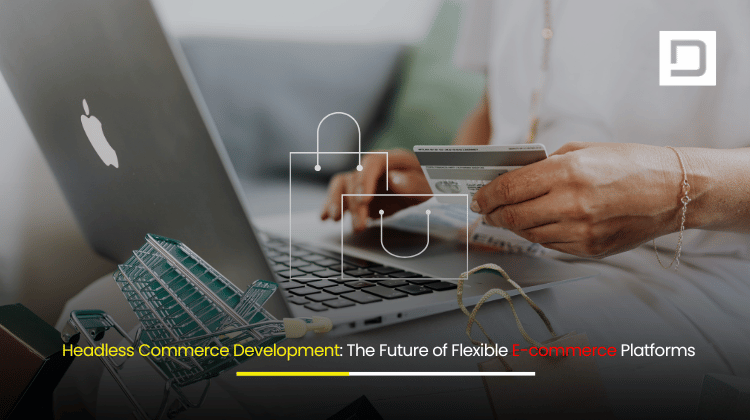Headless Commerce Development: The Future of Flexible E-commerce Platforms
In recent years, the e-commerce landscape has undergone significant transformations. As businesses look for ways to optimize their digital presence and stay ahead of competition, one term has been making waves: headless commerce. But what is headless commerce, and why is it being hailed as the future of e-commerce development? This blog explores the rise of headless commerce, its advantages, and how it can empower businesses to create flexible, scalable, and future-proof online stores.
What is Headless Commerce?
Headless commerce refers to a decoupled architecture in e-commerce, where the front end (what the customer sees) is separated from the back end (where the data, products, and transactions are managed). Unlike traditional e-commerce systems where the front-end and back-end are tightly integrated into a monolithic platform, headless commerce allows businesses to customize and deliver unique customer experiences across multiple platforms using APIs (Application Programming Interfaces).
In a headless commerce model, the “head” is the front-end, which could be anything from a website, mobile app, or even a voice assistant, while the “body” is the back-end, where the data and logic are managed. The two are connected through APIs, allowing businesses to easily update and deploy changes to either side independently.
Key Components of Headless Commerce Architecture
The core of headless commerce development lies in the separation between the front-end and back-end. This is achieved through several key components:
- Front-End Layer (Head):
The front-end is where customers interact with the e-commerce platform. This could be a website, mobile app, or any other digital touchpoint. With headless commerce, businesses have the freedom to choose or create any front-end technology (e.g., React, Angular, Vue.js) without being restricted by the limitations of a traditional e-commerce platform. - Back-End Layer (Body):
The back-end houses the core functionalities of the e-commerce system, such as product management, inventory, orders, payments, and customer data. In a headless setup, the back-end is decoupled from the front-end and provides data and services to the front-end through APIs. - APIs (Application Programming Interfaces):
APIs are the bridge that connects the front-end and back-end, enabling data to flow seamlessly between the two. These APIs ensure that changes made on the back-end (such as updating product information or inventory levels) are reflected instantly on the front-end, delivering a seamless and up-to-date customer experience.
Benefits of Headless Commerce Development
Headless commerce offers several compelling benefits that make it a preferred choice for modern businesses looking to stay competitive in the digital age.
1. Flexibility in Front-End Development
One of the main advantages of headless commerce is the flexibility it offers in front-end development. Since the front-end is decoupled from the back-end, developers have the freedom to choose any technology stack to build and design the front end. Whether you want a custom-built website, a mobile app, or even a voice assistant interface, headless commerce allows businesses to tailor the user experience to match their unique needs.
2. Omnichannel Experience
Consumers now engage with businesses across multiple devices and touchpoints, such as websites, mobile apps, social media, IoT devices, and voice assistants. A headless commerce architecture enables businesses to deliver a consistent, personalized experience across all these channels. Whether a customer is shopping via a mobile app or interacting through a smart speaker, the back-end remains the same, ensuring a seamless omnichannel experience.
3. Faster Time-to-Market
With traditional e-commerce platforms, making changes to the front-end often requires changes to the back-end, leading to long development cycles. In contrast, headless commerce enables businesses to make changes to the front-end and back-end independently, speeding up the development and deployment process. This flexibility can result in faster time-to-market for new features, promotions, and product launches.
4. Scalability and Future-Proofing
As your business grows, you need an e-commerce platform that can scale with you. Headless commerce offers excellent scalability, allowing businesses to handle increased traffic, product listings, and transaction volumes without compromising performance. Furthermore, because headless commerce is built on APIs, it’s easier to integrate with future technologies and platforms. This future-proofing ensures that your e-commerce site can evolve and adapt to the ever-changing digital landscape.
5. Personalization and Customization
Headless commerce gives businesses the freedom to create highly personalized and unique customer experiences. By leveraging customer data and integrating AI-driven tools, businesses can offer personalized recommendations, dynamic pricing, and tailored content. This flexibility allows for deeper customization of the shopping experience, ultimately driving higher customer satisfaction and engagement.
6. Improved Performance and Speed
Since the front-end and back-end are independent, businesses can optimize each layer for maximum performance. For instance, the front-end can be designed to deliver lightning-fast page load times and a smooth user experience, while the back-end can be optimized for managing large volumes of transactions and data. This performance optimization results in a faster, more responsive e-commerce platform, which is critical for reducing bounce rates and improving conversion rates.
7. Cost Efficiency
Although headless commerce may require an initial investment in development, it offers long-term cost savings. The ability to make changes to the front-end without affecting the back-end reduces the cost of ongoing maintenance and upgrades. Additionally, headless commerce’s flexibility allows businesses to reuse components across multiple platforms, reducing redundancy and streamlining operations.
Challenges of Headless Commerce
While headless commerce offers numerous advantages, it’s not without its challenges. Understanding these challenges can help businesses make an informed decision about whether headless commerce is right for them.
1. Complexity in Development
Headless commerce is more complex to implement than traditional monolithic platforms. Businesses need skilled developers to design, build, and maintain both the front-end and back-end. The decoupling of the front-end and back-end requires seamless API integrations, and businesses need to invest in additional resources for development and maintenance.
2. Higher Initial Costs
While headless commerce can save money in the long run, it often comes with higher initial development costs. The custom nature of the platform and the need for specialized developers can make the upfront investment more expensive than traditional e-commerce solutions. However, for businesses that require flexibility and scalability, this can be a worthwhile investment.
3. Managing Multiple Touchpoints
With headless commerce, businesses can deliver an omnichannel experience, but this also means managing multiple touchpoints (website, mobile app, IoT devices, etc.). Ensuring consistency across all platforms can be challenging and requires robust API management and integration strategies.
4. Ongoing Maintenance and Support
Although headless commerce offers flexibility, it also requires ongoing maintenance to ensure that the front-end and back-end remain in sync. Additionally, businesses may need to monitor and update the APIs regularly to ensure smooth functionality across all touchpoints.

Headless Commerce vs. Traditional E-commerce: A Comparison
| Feature | Headless Commerce | Traditional E-commerce |
|---|---|---|
| Flexibility | Highly flexible; can use any front-end technology | Limited flexibility; front-end and back-end are tied together |
| Customization | High level of customization across all platforms | Limited customization due to pre-defined templates |
| Scalability | Easily scalable; designed to handle high traffic | Scalability can be limited by the platform’s infrastructure |
| Time-to-Market | Faster development cycles due to decoupled architecture | Longer development cycles due to tightly integrated system |
| Cost | Higher initial costs; long-term cost savings | Lower initial costs; long-term maintenance can be expensive |
| Omnichannel Experience | Seamless experience across all devices and touchpoints | Limited to one platform or device type |
How Depex Technologies Can Help You Build a Headless Commerce Platform
At Depex Technologies, we specialize in headless commerce development that empowers businesses to create customized, scalable, and future-proof e-commerce platforms. Our team of expert developers understands the nuances of headless commerce and can help you design and implement a solution tailored to your business needs.
Whether you’re a small startup looking for flexibility or an established enterprise aiming to scale your online presence, we have the skills and expertise to bring your vision to life. We offer a dedicated development team for long-term projects, ensuring that your platform evolves with changing business needs and emerging technologies.
Conclusion: The Future of E-commerce Is Headless
In conclusion, headless commerce is rapidly emerging as the future of e-commerce, offering businesses the flexibility, scalability, and customization they need to stay competitive. By decoupling the front-end and back-end, headless commerce enables businesses to deliver personalized, seamless, and omnichannel shopping experiences that customers demand.
If you’re ready to embrace the future of e-commerce and take your online store to the next level, contact Depex Technologies today. Our dedicated team of developers is here to help you build a powerful, flexible headless commerce platform that meets your business needs and exceeds customer expectations.






